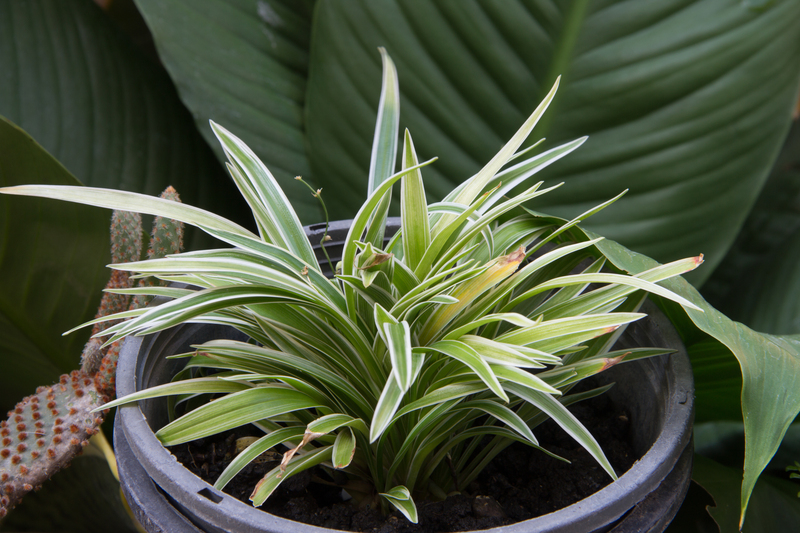Battling Severe Weather: Enduring Garden Strategies for Protection
Posted on 04/06/2025
Battling Severe Weather: Enduring Garden Strategies for Protection
Facing ever-changing weather patterns poses unique challenges for gardeners worldwide. From torrential rains to relentless heatwaves, the impact of severe weather on gardens cannot be underestimated. However, with the right approaches, your green oasis can thrive regardless of what Mother Nature throws your way. This comprehensive guide dives deep into enduring garden strategies for protection, helping you weather any storm with confidence.

Understanding Severe Weather Risks in the Garden
Before formulating a garden protection plan, it's essential to recognize the range of threatening weather conditions. The following are common weather extremes that can damage gardens:
- Heavy rainfall: Saturated soil, flooding, and root rot
- Drought and heat waves: Water stress, scorched plants, stunted growth
- Hail and high winds: Torn foliage, broken stems, uprooted plants
- Late spring frosts: Damage to emerging buds, flowers, and tender plants
- Snow and ice storms: Broken branches, crushed perennials, winterkill
Understanding your garden's microclimate lets you anticipate which challenges are most likely in your area. Local weather data, gardening forums, and extension offices can offer invaluable insights into historic weather trends affecting your region.
Soil Health: The Foundation of Weather-Resilient Gardens
A healthy, well-structured soil builds the first line of defense against weather adversity:
- Water Retention: Rich organic matter enables soil to absorb and hold moisture during droughts and heavy rains.
- Drainage: Good soil structure prevents waterlogging and reduces the risk of root rot in soggy weather.
- Root Support: Deep, healthy roots help anchor plants against wind and facilitate recovery after storm damage.
Key Steps to Improve Soil Resilience
- Add compost: Each season, enrich your beds with organic compost to foster microbial life and boost soil structure.
- Use mulch: A layer of organic mulch (straw, shredded leaves, bark) insulates roots against heat, cold, and helps retain moisture.
- Avoid compaction: Minimize heavy foot or wheel traffic, and use raised beds or broadforks for trouble spots.
- Test soil regularly: Analyze your garden soil every 1-2 years to monitor pH and nutrient levels and adjust amendments as needed.
Smart Plant Selection: A Key to Storm-Ready Gardens
Choosing weather-resistant plants is vital in battling severe weather. Select varieties and species naturally adapted to local extremes:
Drought-Tolerant Plants
- Lavender
- Russian Sage
- Yarrow
- Catmint
- Native prairie grasses
Flood-Tolerant Plants
- Swamp Milkweed
- Iris
- Joe-Pye Weed
- Buttonbush
Wind- and Hail-Resistant Varieties
- Low-growing groundcovers and perennials
- Bamboo and willows (for wind barriers)
- Woody shrubs with flexible branches (e.g., dogwood, viburnum)
Pro-tip: Whenever possible, select native plants-- they're naturally suited for your climate and better able to withstand local weather conditions.
Garden Design for Severe Weather Protection
Smart landscape design can dramatically boost your garden's ability to endure storms and temperature swings. Here are advanced strategies for creating a weather-hardy landscape:
Strategic Placement
- Windbreaks: Plant rows of trees or tall shrubs on the side of prevailing winds. Evergreens, hedges, and even garden fences can filter harsh gusts before they reach your veg patch or flower beds.
- Stormwater management: Use swales, rain gardens, and permeable pathways to direct runoff away from delicate plants and toward rain-loving areas.
- Microclimates: Position sensitive plants near walls, fences, or under tree canopies to buffer against temperature extremes.
Raised Beds and Contouring
- Raised gardens: Elevate root zones above saturated ground and improve drainage during prolonged rains.
- Contour planting: On slopes, build terraces or berms to slow runoff and prevent erosion.
Flexible Structures
- Removable row covers: Use hoops and light fabric for quick protection from frost, hail, or pest surges after storms.
- Temporary shade: Set up shade cloth, old sheets, or umbrellas during heatwaves to keep shallow-rooted and tender plants cool.
Protecting Gardens from Heavy Rain and Flooding
Sudden downpours and saturated soil can wreak havoc, washing away nutrients and dislodging young plants. Use these enduring strategies to shield your garden during wet weather:
- Add organic matter: Soil rich in compost drains better, reducing root rot risks.
- Plant densely: Groundcovers can stabilize soil and reduce erosion from pounding rain.
- Install rain gardens: Divert excess water to dedicated basins filled with moisture-loving plants.
- Ensure proper drainage: Regularly check and clear garden drains, gutters, and nearby storm grates.
- Use raised beds: Lift vulnerable crops above flood-prone ground levels.
Defending Against Drought and Heatwaves
Gardeners in hot and dry climates must focus on strategies for water conservation and heat protection.
- Mulching: Apply thick organic mulch to minimize water evaporation and keep soil temperatures stable.
- Water deeply but infrequently: Encourage roots to grow deep, where soil stays cooler and moister.
- Drip irrigation: Use soaker hoses or drip lines to deliver moisture right at the root zone, minimizing waste.
- Shade cloth: Create temporary or permanent shade during extreme heat spikes for the most delicate areas.
- Group plants by water needs: This ensures efficient irrigation and prevents overwatering/dryouts in shared beds.
Minimizing Wind and Hail Damage
Sudden windstorms and hail can cause physical destruction overnight. Careful planning and a few ingenious tricks help secure your garden in turbulent weather.
- Staking and supports: Use sturdy stakes, cages, or trellises for tall or top-heavy plants.
- Flexible netting: Protective mesh or bird netting can deflect hail stones and shield young plants from breakage.
- Windbreaks: Hedges, walls, or garden fencing reduce wind speed and limit damage to your most vulnerable garden beds.
- Quick covers: Keep tarps, burlap, or cloches ready for last-minute storm forecasts.
Frost and Cold Weather Protection Strategies
Spring and fall frosts can catch gardeners off guard, especially with unpredictable weather swings. Prepare your garden using the following tried-and-true methods:
- Floating row covers: Lay fabric directly over crops at dusk to trap radiant heat from the soil overnight.
- Cold frames and cloches: Small, clear covers create a warm microclimate for young plants or late crops.
- Mulching: Heavier mulch (straw, pine needles) acts as insulation against sudden freezes.
- Windbreaks: As above, they're invaluable in preventing cold, drying winds that intensify frost harm.
- Watering before frost: Slightly moist soil retains more heat than dry soil and can buffer root temperature dips.
Year-Round Severe Weather Preparedness: Maintenance Checklist
- Monitor forecasts: Stay alert to impending storms or heatwaves and prepare protections in advance.
- Prune regularly: Remove dead/damaged wood yearly; this reduces breakage during wind or ice storms.
- Maintain drainage: Check for blocked drains and remove debris in early spring and fall.
- Rotate crops: Practice crop rotation to avoid weakening soil structure and build disease resistance.
- Inventory supplies: Stock backup row covers, mulch, stakes, and irrigation parts for rapid deployment.
Eco-Friendly Weather Protection: Sustainable Solutions
Sustainability and severe weather gardening go hand-in-hand. Modern climate-resilient gardens utilize methods that are eco-friendly and enhance long-term health:
- Rainwater harvesting: Collect runoff in barrels or cisterns for garden use during drought spells.
- Native & pollinator plants: Support ecosystem resilience while beautifying your landscape and hosting beneficial insects.
- Flexible, low-impact materials: Use recycled lumber, bamboo stakes, and biodegradable row covers wherever possible.
- Integrated pest management: Diverse plantings and insect habitats create natural checks on pest outbreaks after storms.

Community Resources and Support Networks
Don't go it alone! Severe weather gardening is easier with the advice and encouragement of fellow enthusiasts:
- Local gardening clubs: Exchange emergency tips and share resources for frost covers, mulch, seeds, and more.
- Extension services: Tap into weather alerts and climate-specific gardening guidance for your region.
- Online forums: Year-round discussions for troubleshooting, digital weather tracking, and sharing post-storm recovery tactics.
Conclusion: Building Resilience in Every Season
Severe weather is an inescapable part of modern gardening, but your response can turn adversity into opportunity. From improving soil health to strategic plant choices, design, and active crisis management--every thoughtful action you take strengthens your garden's staying power. By implementing these enduring strategies for garden protection, you ensure that your patch of green will flourish despite the harshest weather challenges. Battling severe weather is ongoing, but with preparation and adaptability, your garden will stand resilient for many seasons to come.
Remember: A well-prepared gardener is a successful gardener--no matter what the sky brings!

